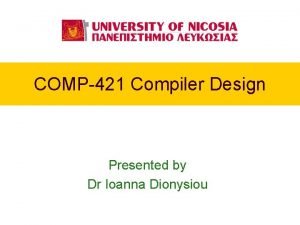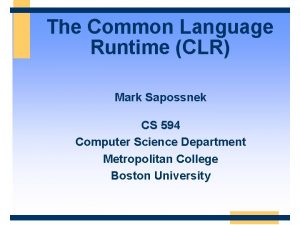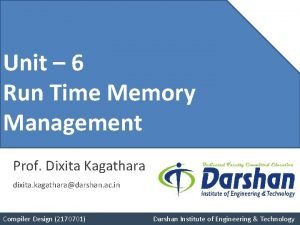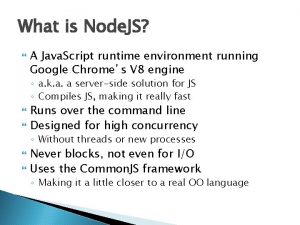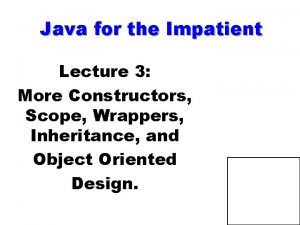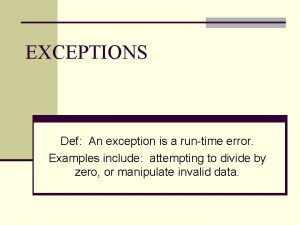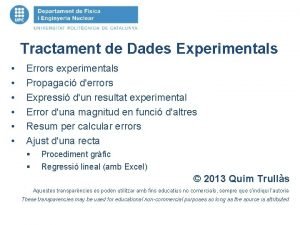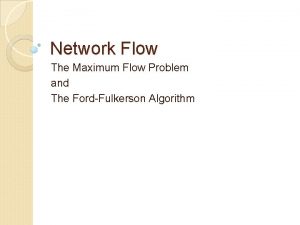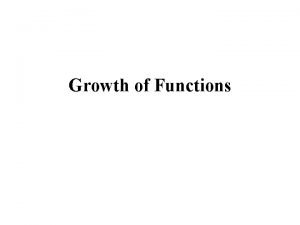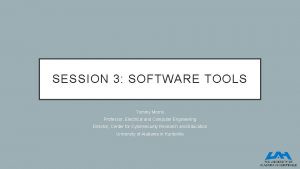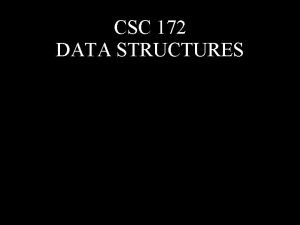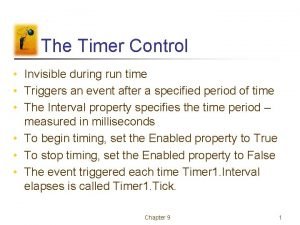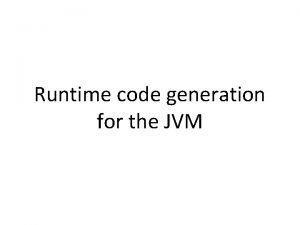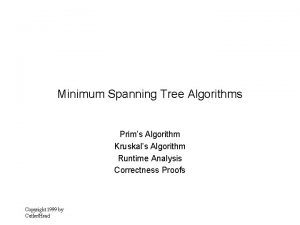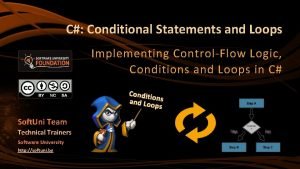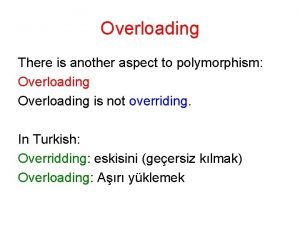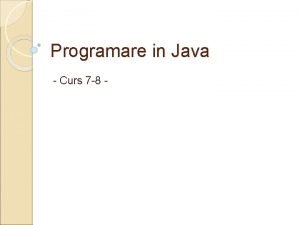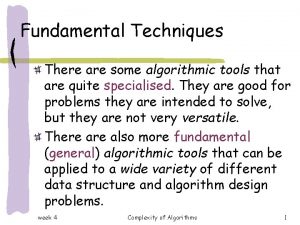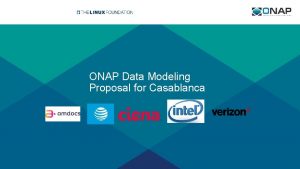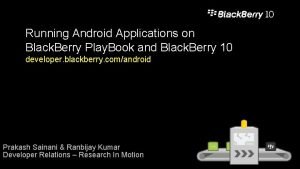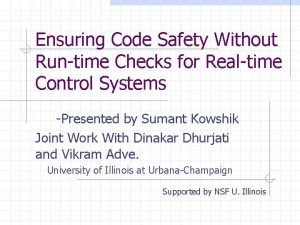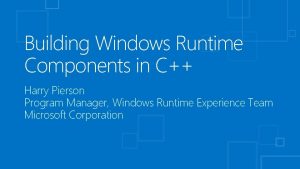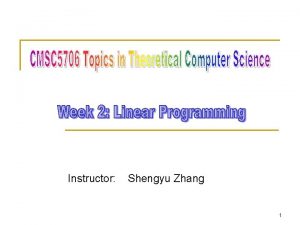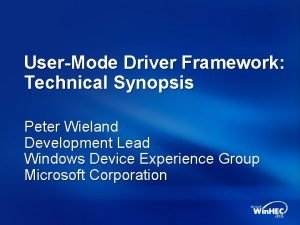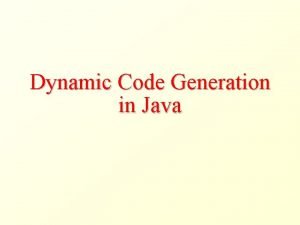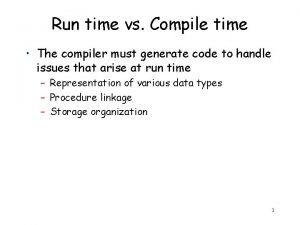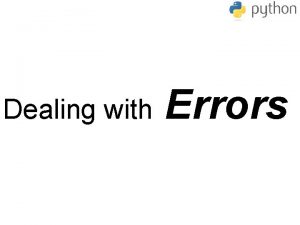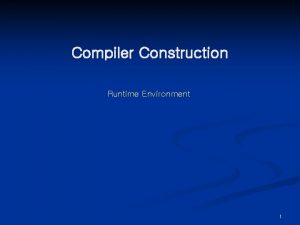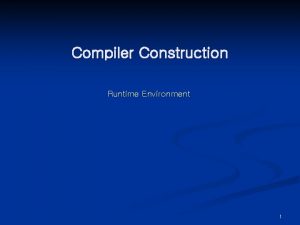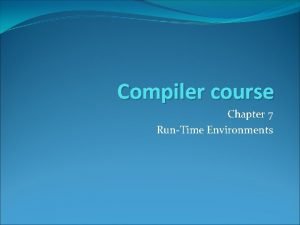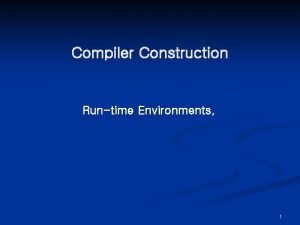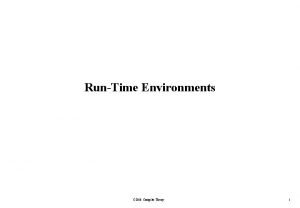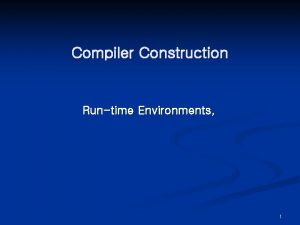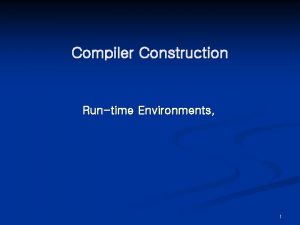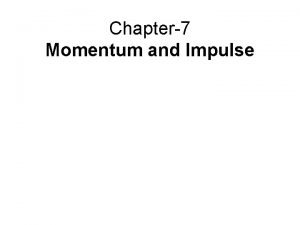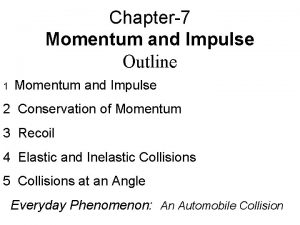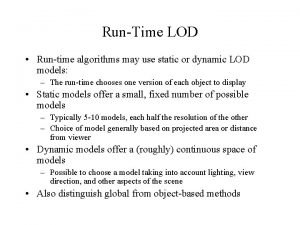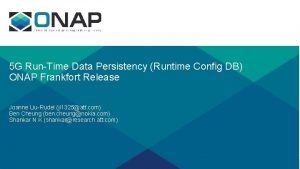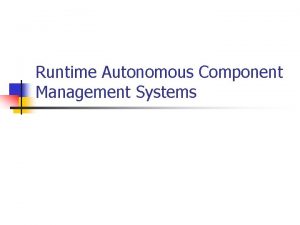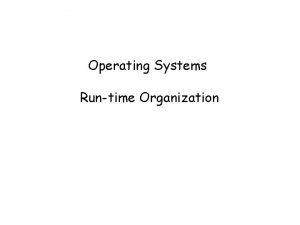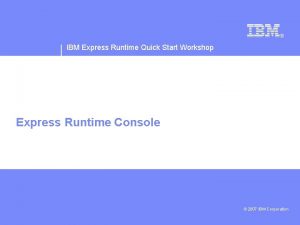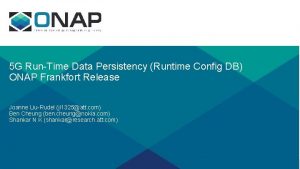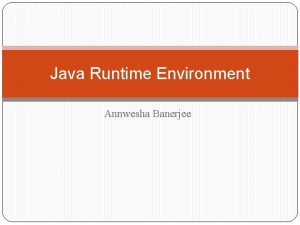RunTime Environment Chapter7 Instructor Afifa Wajid Outline Compiler

























































- Slides: 57

Run-Time Environment Chapter#7 Instructor: Afifa Wajid

Outline • Compiler must do the storage allocation and provide access to the variables and data. • Memory Management • Stack Allocation • Heap Management • Garbage collection

Introduction • A compiler must accurately implement the abstractions embodied in the source language definition. • These abstractions typically include such as names, scopes, bindings, data types, operators, procedures, parameters, and flow-of-control constructs. • The compiler creates and manages a run-time environment in which it assumes its target programs are being executed.

Storage Organization • From the perspective of the compiler writer, the executing target program run in its own logical address space in which each program value has a location. • The management and organization of this logical address space is shared between the compiler, operating system, and target machine.

Sub-division of run-time memory into code and data areas

Storage Organization • Code: The size of the generated target code is fixed at compile time, so the compiler can place the executable target code in an area Code. • Static: The size of some program data objects, and data generated by the compiler, such as information to support garbage collection, may be known at compile time, and these data objects can be placed in area called Static.

Storage Organization • To maximize the utilization of space at run time, the two areas, Stack and Heap, are at the opposite ends of the remainder of the address space. • These areas are dynamic; their size can change as the program executes. These areas grow towards each other as needed. • The stack is used to store data structures called activation records that generated during procedure calls.

Static Vs. Dynamic Storage Allocation • Static: Compile Time • Dynamic: Runtime Allocation • Many Compilers uses some combination of two strategies: i. Stack Storage: for local variables, parameters and so on ii. Heap Storage: Data that may outlive the call to the procedure that created it, also known as Virtual memory.

Garbage Collection • To support heap management, "garbage collection" enables the runtime system to detect useless data elements and reuse their storage, even if the programmer does not return their space explicitly. • Automatic garbage collection is an essential feature of many modern languages nowadays.

Stack Allocation of space • For managing procedure calls • Stack grows with each call and shrinks with each procedure return/terminate. • Each procedure call pushes an activation record into the stack.

Activation Trees • Stack Allocation would not be feasible if procedure calls or activation of procedures did not nest in time. • The main function has three tasks: a. Read. Array b. Sets the sentinels c. Calls quicksort on the entire data array

• If an activation of procedure p calls procedure q, then that activation of q must end before the activation of p can end. There are three common cases: i. The activation of q terminates normally. ii. The activation of q, or some procedure q called, either directly or indirectly, aborts; i. e. , it becomes impossible for execution to continue. In that case, p ends simultaneously with q. iii. The activation of q terminates because of an exception that q cannot handle.

Activation Tree • Represent the activations of procedures during the running of an entire program by a tree, called an activation tree. • Each node corresponds to one activation, and the root is the activation of the "main" procedure that initiates execution of the program. • At a node for an activation of procedure p, the children correspond to activations of the procedures called by this activation of p. We show these activations in the order that they are called, from left to right. • Notice that one child must finish before the activation to its right can begin.

Behavior of the program • The sequence of procedure calls corresponds to a preorder traversal of the activation tree. • The sequence of returns corresponds to a Postorder traversal of the activation tree. • The order in which these activations were called is the order in which they appear along the path to N, starting at the root , and they will return in the reverse of that order.

Quicksort Program

Activation Example enter main () enter read. Array() leave read. Array() enter quicksort (1, 9) enter partition(1, 9) leave partition(1, 9) enter quicksort (1, 3) …… leave quicksort (1, 3) enter quicksort (5, 9) ……. leave quicksort(5, 9) leave quicksort (1 , 9) leave main()

Activation Tree

Activation Records • Procedure calls and returns are usually managed by a runtime stack called the control stack. • Each live activation has an activation record on the control stack, with the root of the activation tree at the bottom, and the entire sequence of activation records on the stack corresponding to the path in the activation tree.

Example: • If control is currently in th e activation q(2, 3) then the activation record for q(2, 3) is at the top of the control stack. • Just below is the activation record for q(l, 3) , the parent of q(2, 3) in the tree. • Below that is the activation record q(l, 9), and at the bottom is the activation record for m, the main function and root of the activation tree.

General Activation Tree

Data in activation record • Temporary values, such as those arising from the evaluation of expressions. • Local data belonging to the procedure whose activation record this is. • A saved machine status, with information about the state of the machine just before the call to the procedure. • An "access link" may be needed to locate data needed by the called procedure. • A control link, pointing to the activation record of the caller. • Space for the return value of the called function. • The actual parameters used by the calling procedure. Commonly, these values are not placed in the activation record but rather in registers.

Heap Management • The heap is the portion of the store that is used for data that lives indefinitely, or until the program explicitly deletes it. • Many languages enable us to create objects or other data whose existence is not tied to the procedure activation that creates them. • So they continue to exist long after the procedure that created them is gone. • Such objects are stored on a heap.

Memory Manager • The memory manager keeps track of all the free space in heap storage at all times. • It performs two basic functions: 1) Allocation 2) Deallocation

Allocation • When a program requests memory for a variable or object, the memory manager produces a chunk of contiguous heap memory of the requested size. • If no chunk of the needed size is available, it seeks to increase the heap storage space by getting consecutive bytes of virtual memory from the operating system. • If space is exhausted, the memory manager passes that information back to the application program.

Deallocation • The memory manager returns deallocated space to the pool of free space , so it can reuse the space to satisfy other allocation requests. • Memory managers typically do not return memory to the operating system, even if the program's heap usage drops.

Properties of Memory Manager • Thus, the memory manager must be prepared to service, in any order, allocation and deallocation requests of any size , ranging from one byte to as large as the program's entire address space. • Space efficiency (minimize the heap space needed by the program) • Program efficiency (better use of memory subsystems) • Low Overhead (we wish to minimize the overhead the fraction of execution time spent performing allocation and deallocation. )

Memory Hierarchy of a Computer • Register usage is tailored for the specific applications and managed by the code that a compiler generates. • All the other levels of the hierarchy are managed automatically; in this way, not only is the programming task simplified, but the same program can work effectively across machines with different memory configurations. • With each memory access, the machine searches each level of the memory in succession, starting with the lowest level, until it locates the data.

Memory Hierarchy

Locality in programs • Locality means that programs spend most of their time executing small fraction of code and touching only small fraction of data. • Types of locality: i. Temporal Locality: if the memory location it accesses is more likely to be accessed again. i. Spatial Locality if memory locations close to the location accessed are likely to be accessed within a short period of time.

Reducing Fragmentation • Initially the heap is one contiguous unit of free space. • As allocation and deallocation occurs, the space is broken up into free and used chunks. • Free chunks of memory are referred to as holes. • With each allocation request, the memory manager must place the requested chunk of memory into a large-enough hole. • With each deallocation request, the freed chunks of memory are added back to the pool of free space. • If we are not careful, the memory may end up getting fragmented, consisting of large numbers of small, noncontiguous holes.

Best-Fit and Next-Fit Object Placement • reduce fragmentation by controlling how the memory manager places new objects in the heap. • good strategy for minimizing fragmentation is to allocate the requested memory in the smallest available hole. • This best-fit algorithm tends to spare the large holes to satisfy subsequent , larger requests. • An alternative, called first-fit, where an object is placed in the first hole in which it fits, takes less time to place objects, but has been found inferior to best-fit in overall performance.

Manual Deallocation Request • Any storage that will no longer be accessed should be deleted. • Any storage that may be referenced must not be deleted. • Unfortunately, it is hard to enforce either of these properties

Problems with manual deallocation • Manual memory management is error-prone. • The common mistakes take two forms: failing ever to delete data that cannot be referenced is called a memory leak error, and referencing deleted data is a dangling-pointer-dereference error. • Although memory leaks may slow down the execution of a program due to increased memory usage, they do not affect program correctness. • Dereferencing a dangling pointer always creates a program error that is hard to debug. As a result, programmers are more inclined not to deallocate a variable if they are not certain it is unreferencable.

Garbage Collection • Data that cannot be referenced is generally known as garbage. • Many high-level programming languages remove the burden of manual memory management from the programmer by offering automatic garbage collection, which deallocates unreachable data.

Design Goals for Garbage Collectors • Garbage collection is the reclamation of chunks of storage holding objects that can no longer be accessed by a program. • The type of the object tell us how large the object is and which component of the object contain references to other object.

Reachability • We refer to all the data that can be accessed directly by a program, without having to dereference any pointer, as the root set. • A program obviously can reach any member of its root set at any time. • Recursively, any object with a reference that is stored in the field members or array elements of any reachable object is itself reachable.

Reference Counting Garbage Collector • It identifies garbage as an object changes from being reachable to unreachable; the object can be deleted when its count drops to zero. • With a reference-counting garbage collector, every object must have a field for the reference count.

Maintaining Reference Count i. Object Allocation. The reference count of the new object is set to 1. ii. Parameter Passing. The reference count of each object passed into a procedure is incremented. iii. Reference Assignments. For statement u = v, where u and v are references, the reference count of the object referred to by v goes up by one, and the count for the old object referred to by u goes down by one.

iv. Procedure Returns. As a procedure exits, all the references held by the local variables of that procedure activation record must also be decremented. v. Transitive Loss of Reachability. Whenever the reference count of an object becomes zero, we must also decrement the count of each object pointed to by a reference within the object.

• Example 7. 11 from book.

• Deferred Reference Counting : eliminates the overhead associated with updating the reference count. • Reference counts do not include references from the root set of the program. • An object is not considered to be garbage until the entire root set is scanned and no references to the object are found.

Advantages of Reference Count • Garbage collection is performed in an incremental fashion. • Attractive algorithm when timing deadlines must be met. • Attractive algorithm for interactive applications where long, sudden pauses are unacceptable. • Garbage is collected immediately, keeping space usage low

Trace – Based Collection • Instead of collecting garbage as it is created, trace-based collectors run periodically to find unreachable objects and reclaim their space. • Usually trace-based collector is run whenever the free space is exhausted or its amount drops below some threshold.

Mark and Sweep Collector • Mark-and-sweep garbage-collection algorithms are straightforward. • The algorithm find all the unreachable objects, and put them on the list of free space. • Working of Algorithm: Algorithm visits and "marks" all the reachable objects in the first tracing step and then "sweeps" the entire heap to free up unreachable objects.

Algorithm • Input: A root set of objects, a heap, and a free list, called Free, with all the unallocated chunks of the heap. • Output: A modified Free list after all the garbage has been removed. • Method: List Free holds objects known to be free. A list called Unscanned, holds objects that we have determined are reached, but whose successors we have not yet considered.

• The Unscanned list is empty initially. • Each object includes a bit to indicate whether it has been reached (the reached- bit). • Before the algorithm begins, allocated objects have the reached bit set to 0.

Algorithm

Relationship among objects during the marking phase

Sweep Phase • Sweep Phase: § Line (10) puts free and unreached objects on the Free list, one at a time. § Line (11) handles the reachable objects. We set their reachedbit to 0, in order to maintain the proper preconditions for the next execution of the garbage-collection algorithm.

Mark-and-Compact Garbage Collector • Relocating collectors move reachable objects around in the heap to eliminate memory fragmentation. • It is common that the space occupied by reachable objects is much smaller than the freed space. • Thus, after identifying all the holes instead of freeing them individually, one attractive alternative is to relocate all the reachable objects into one end of the heap, leaving the entire rest of the heap as one free chunk.

Mark-and-Compact • A mark-and-compact collector, compacts objects in place. • Relocating in place reduces memory usage.

Mark-and-Compact Algorithm • The Algorithm has three phases: 1) First is a marking phase, similar to that of the mark-and-sweep algorithms. 2) Second, the algorithm scans the allocated section of the heap and computes a new address for each of the reachable objects. 3) Finally, the algorithm copies objects to their new locations, updating all references in the objects to point to the corresponding new locations

Algorithm • Input: A root set of objects, a heap, and free, a pointer marking the start of free space. • Output: The new value of pointer free. • Method: It uses the following data structure: a) An Unscanned List. b) Reached bits in all objects. c) The pointer free, which marks the beginning of unallocated space in the heap. d) The table New. Location. This structure could be a hash table, search tree, or another structure that implements the two operations: § Set New. Location(o) to a new address for object o. § Given object 0 , get the value of New. Location(o)



• Line (8) starts the free pointer at the low end of the heap. • In this phase, we use free to indicate the first available new address. We create a new address only for those objects 0 that are marked as reached. • Object o is given the next available address at line (10), and at line (11) we increment free by the amount of storage that object o requires, so free again points to the beginning of free space.

• In the final phase, lines (13) through (17) , we again visit the reached objects, in the same from-the-Ieft order. • Lines (15) and (16) replace all internal pointers of a reached object o by their proper new values, using the New. Location table. • Then, line (17) moves the object o, to its new location. • Finally, lines (18) and (19) retarget pointers in the elements of the root set that are not themselves heap objects.
 Storage organization in compiler design
Storage organization in compiler design Microsoft common language runtime native compiler
Microsoft common language runtime native compiler Subdivision of runtime memory in compiler design
Subdivision of runtime memory in compiler design Javascript runtime environment
Javascript runtime environment Cross compiler in compiler design
Cross compiler in compiler design Lex yacc example
Lex yacc example Environment of business finance
Environment of business finance It in a sentence
It in a sentence Spark runtime architecture
Spark runtime architecture Difference between compile time and runtime
Difference between compile time and runtime An exception is a runtime error
An exception is a runtime error Runtime error 9
Runtime error 9 Ford fulkerson runtime
Ford fulkerson runtime Asymptotic runtime
Asymptotic runtime In future grid runtime adaptable insertion service used for
In future grid runtime adaptable insertion service used for Openplc arduino
Openplc arduino Dfs runtime
Dfs runtime Heapify runtime
Heapify runtime Heapify runtime
Heapify runtime The control which is invisible at run time
The control which is invisible at run time Java runtime code generation
Java runtime code generation Prims algorithm runtime
Prims algorithm runtime Softuni judge runtime error
Softuni judge runtime error Futuregrid
Futuregrid Compile time polymorphism java
Compile time polymorphism java Runtime error 7 out of memory
Runtime error 7 out of memory What are the example of control hijacking attack
What are the example of control hijacking attack Runtime error index out of bounds
Runtime error index out of bounds Matrix multiplication time complexity
Matrix multiplication time complexity Casablanca runtime
Casablanca runtime Blackberry
Blackberry Basic runtime checks
Basic runtime checks Windows runtime component
Windows runtime component Kinect for windows runtime
Kinect for windows runtime Simplex algorithm runtime
Simplex algorithm runtime Kernel mode driver framework runtime
Kernel mode driver framework runtime Java create class dynamically
Java create class dynamically Uml structural diagrams
Uml structural diagrams Compile time vs run time
Compile time vs run time Runtime programming
Runtime programming In futuregrid runtime adaptable
In futuregrid runtime adaptable Logical error in python
Logical error in python Basic instructor course texas
Basic instructor course texas Cyan medical terminology
Cyan medical terminology Delmar cengage learning instructor resources
Delmar cengage learning instructor resources Nra certified instructor logo
Nra certified instructor logo Human factors instructor
Human factors instructor Instructor vs teacher
Instructor vs teacher Tcole advanced instructor course
Tcole advanced instructor course Ac 61-65
Ac 61-65 How to become an nrp instructor mentor
How to become an nrp instructor mentor Basic instructor course texas
Basic instructor course texas Participante silencioso
Participante silencioso Basic instructor course tcole
Basic instructor course tcole Basic instructor course #1014
Basic instructor course #1014 Instructor office hours
Instructor office hours Naismith was an instructor of
Naismith was an instructor of Instructor operating station
Instructor operating station
